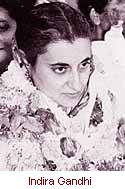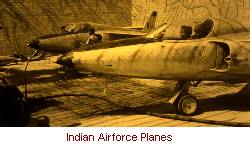|
|
|
|
 
|
India/Pakistan
|
After World War II, India and Britain resume talks on Indian independence. The Muslim League asks for India to be divided into two separate states. Congress, however, does not agree to the division of India.
 An interim government is installed. Jawaharlal Nehru, the leader of Congress, becomes India's first prime minister.
An interim government is installed. Jawaharlal Nehru, the leader of Congress, becomes India's first prime minister.
Read more about
Jawaharlal Nehru.
The Congress and Muslim League leaders agree to a partition of the country along religious lines, with predominantly Hindu areas allocated to India and predominantly Muslim areas to Pakistan.
India gains her independence. Pakistan is recognised as a separate country. The division of Pakistan and India leads to a period of dislocation for the people as many Hindus move from Pakistan into India, and many Muslims move from India to Pakistan.
Read more about the
history
of India and Pakistan.
Disputes between India and Pakistan arise over the states of Junagadh, Hyderabad, and Kashmir - states that were not allocated to either India or Pakistan during independence. The maharaja of Kashmir, facing threats from tribal groups supported by Pakistan, asks India for help. Fighting breaks out between India and Pakistan over Kahsmir.
 A United Nations peacekeeping force is sent in to arrange a cease-fire between India and Pakistan. Although a cease-fire line is drawn out, partitioning Kashmir, the dispute between the two countries is not resolved.
A United Nations peacekeeping force is sent in to arrange a cease-fire between India and Pakistan. Although a cease-fire line is drawn out, partitioning Kashmir, the dispute between the two countries is not resolved.
Read more on the
Kaskmir crisis.
India becomes a republic. President Nehru becomes a leading spokesman for nonalignment, the idea that other countries should refuse to take sides in the political struggle between the Soviet Union and the United States.
Pakistan begins to receive arms from the United States. This worsens hostilities between India and Pakistan.
Khrushchev visits India. The Soviet Union begins an aid program to India.
Tension mounts between India and China after India grants asylum to Tibet's spiritual leader. China had invaded Tibet in 1950. Because of this, China felt that India was undermining its authority by granting asylum to the Tibetan spiritual leader. Meanwhile, Sino-Indian relationships had been strained by border conflicts between China and India.
Fighting breaks out between India and China. Indian forces are defeated. India appeals to the United States for help. The United States responds and Chinese forces soon retreat. This improves US-Indian ties.
Sino-Indian conflict.
Nehru passes away and is succeeded by Lal Bahadur Shastri as India's second prime minister.
With substantial military support from the United States, Pakistani troops cross the cease-fire line in Kashmir. India responds by invading Pakistan proper.
A UN cease-fire is agreed upon by both sides. By this time, both sides had suffered great loss in manpower and ammunition.
A Soviet-sponsored South Asian peace conference is held. Both India and Pakistan agree to ending the war and restoring normal and peaceful relations. They agree to mutual troop withdrawal to the lines held before August 1965.
 Indira Gandhi is elected by the Congress Party to become India's next prime minister. During her first year in office she visits Washington, D.C., and wins support for India.
Indira Gandhi is elected by the Congress Party to become India's next prime minister. During her first year in office she visits Washington, D.C., and wins support for India.
Find out more about the life of
Indira Gandhi.
India and the Soviet Union sign a 20-year Treaty of Peace and Friendship and Cooperation. In this treaty, the Soviet Union agree to provide India with military arms.
 Fighting breaks out in Bengal. The Soviets take the side of India, while the United States takes the side of Pakistan. The war ends when the Indians defeat the Pakistanis. East Pakistan becomes the new state of Bangladesh.
Fighting breaks out in Bengal. The Soviets take the side of India, while the United States takes the side of Pakistan. The war ends when the Indians defeat the Pakistanis. East Pakistan becomes the new state of Bangladesh.
The India-Pakistan War.
Indira Gandhi authorises the atomic bomb explosion test of a plutonium implosion bomb under the Rajasthan desert. The United States responds by imposing economic sanctions on India.
Background
on India Pakistan weapons test.
Indira Gandhi and Pakistani President Mohammad Zia-ul-Haq agree to begin talks on a non-aggression treaty.
Indira Gandhi holds a conference of nonaligned third-world nations. It is attended by diplomats from 101 countries.
Indira Gandhi is assassinated by Sikh members of her bodyguard.
Watch a cnn video clip of the event of the
assassination of Indira Gandhi.
Rajiv Gandhi wins the 1984 election by the largest majority ever amassed by any of his ancestors. Indo-U.S. relations improve during the last half of the 1980s with greater trade, scientific cooperation, and cultural exchanges.
India and Pakistan continue to clash over the region of Kashmir. Both nations also engage in nuclear weapons programmes.
|




 An interim government is installed. Jawaharlal Nehru, the leader of Congress, becomes India's first prime minister.
An interim government is installed. Jawaharlal Nehru, the leader of Congress, becomes India's first prime minister.
 A United Nations peacekeeping force is sent in to arrange a cease-fire between India and Pakistan. Although a cease-fire line is drawn out, partitioning Kashmir, the dispute between the two countries is not resolved.
A United Nations peacekeeping force is sent in to arrange a cease-fire between India and Pakistan. Although a cease-fire line is drawn out, partitioning Kashmir, the dispute between the two countries is not resolved.
 Indira Gandhi is elected by the Congress Party to become India's next prime minister. During her first year in office she visits Washington, D.C., and wins support for India.
Indira Gandhi is elected by the Congress Party to become India's next prime minister. During her first year in office she visits Washington, D.C., and wins support for India.
 Fighting breaks out in Bengal. The Soviets take the side of India, while the United States takes the side of Pakistan. The war ends when the Indians defeat the Pakistanis. East Pakistan becomes the new state of Bangladesh.
Fighting breaks out in Bengal. The Soviets take the side of India, while the United States takes the side of Pakistan. The war ends when the Indians defeat the Pakistanis. East Pakistan becomes the new state of Bangladesh.
